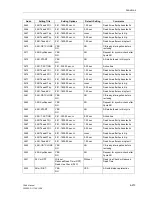
Functions
6-210
7SA6 Manual
C53000-G1176-C156-2
The dead time after single-pole tripping (if set)
1.AR Tdead1Trip
(address
3456
)
should be long enough for the short-circuit arc to be extinguished and the surrounding
air to be de-ionized so that the reclosure promises to be successful. The longer the
line is, the longer this time should be due to the recharging of the conductor capaci-
tances. The typical values are 0.9 s to 1.5 s.
For three-pole tripping (address
3457
1.AR Tdead3Trip
) the stability of the network
is the main concern. Since the disconnected line cannot transfer any synchronizing
forces, only a short dead time is often permitted. The usual values are 0.3 s to 0.6 s.
If the device is operating with a synchronism check (refer also to section 6.15), a long-
er time may be tolerated under certain circumstances. Longer three-pole dead times
are also possible in radial networks.
In the control mode with PICKUP it is possible to make the dead times dependent on
the type of fault detected by the initiating protection function(s):
address
3453
1.AR Tdead 1Flt
is the dead time after 1-phase starting,
address
3454
1.AR Tdead 2Flt
is the dead time after 2-phase starting,
address
3455
1.AR Tdead 3Flt
is the dead time after 3-phase starting.
If the dead time is to be the same for all types of faults, set all three parameters the
same. Note that these settings only cause different dead times for different starting
(fault detection)
conditions. The tripping can only be three-pole.
With the setting
starts 3p AR
applied in address
3407
EV. FLT. MODE
when
setting the response to evolving faults (see above under “General”, page 205), it is
possible to apply a separate dead time
1.AR: Tdead EV.
(address
3458
) for the
three-pole dead time after clearance of the evolving fault. Stability aspects are also de-
cisive here. Normally the setting constraints are similar to address
3457
1.AR
Tdead3Trip
.
Under address
3459
1.AR: CB? CLOSE
it can be determined whether circuit-breaker
ready must be interrogated before this first reclosure. With the setting
Yes
, the dead
time may be extended if the circuit-breaker is not ready for a CLOSE–TRIP–cycle
when the dead time expires. At most the dead time can be extended by the
CB TIME
OUT
; this was set for all reclosure cycles together under address
3409
(see above).
Details about the circuit-breaker monitoring can be found in the function description,
section 6.14.1, under subtitle “Interrogation of Circuit-Breaker Ready”, page 192.
If there is a danger of stability problems in the network during a three-pole dead time,
you should set address
3460
1.AR SynRequest
to
Yes
. In this case a check is
made before every reclosure following three-pole tripping whether the voltages of the
feeder and busbar are sufficiently synchronized. This on condition that either the inter-
nal synchronism and voltage check function is available or that an external device is
available for synchronism check. If only single-pole reclose cycles are executed or no
stability problems are expected during three-pole dead times (e.g. due to closely
meshed networks or in radial networks), set address
3460
to
No
.
2nd to 4th
Reclosure Cycle
If several cycles were selected during the configuration of the scope of functions (sec-
tion 5.1), it is possible to set individual reclosure parameters for the 2nd to 4th cycles.
The options are the same as for the 1st cycle. Again only some of the parameters
shown below will be available depending on the selections made during configuration
of the scope of protection function (section 5.1).
For the 2nd cycle:
Address
3461
2.AR: START
; determines if starting in 2nd cycle is allowed at all
Address
3462
2.AR: T-ACTION
; action time for the 2nd cycle
Address
3464
2.AR Tdead 1Flt
; dead time after 1-phase starting
Address
3465
2.AR Tdead 2Flt
; dead time after 2-phase starting
Содержание siprotec 7SA6
Страница 2: ...Siemens Aktiengesellschaft Book No C53000 G1176 C156 2 ...
Страница 18: ...xviii 7SA6 Manual C53000 G1176 C156 2 ...
Страница 32: ...Introduction 1 14 7SA6 Manual C53000 G1176 C156 2 ...
Страница 82: ...Hardware and Connections 2 50 7SA6 Manual C53000 G1176 C156 2 ...
Страница 119: ...SIPROTEC 4 Devices 4 25 7SA6 Manual C53000 G1176 C156 2 Figure 4 20 CFC Logic example ...
Страница 190: ...Configuration 5 62 7SA6 Manual C53000 G1176 C156 2 ...
Страница 559: ...Control During Operation 7 45 7SA6 Manual C53000 G1176 C156 2 Figure 7 45 Circuit breaker trip test in DIGSI 4 ...
Страница 652: ...Installation and Commissioning 8 78 7SA6 Manual C53000 G1176 C156 2 ...
Страница 724: ...Technical Data 10 56 7SA6 Manual C53000 G1176 C156 ...
Страница 800: ...Appendix A 76 7SA6 Manual C53000 G1176 C156 2 ...
Страница 866: ...Appendix B 66 7SA6 Manual C53000 G1176 C156 2 ...










































